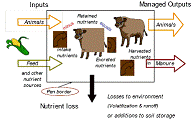Biological Systems Engineering, Department of

Department of Agricultural and Biological Systems Engineering: Presentations and White Papers
Date of this Version
6-20-2007
Document Type
Article
Abstract
The excessive application of manure on cropland areas can cause nutrients to accumulate near the soil surface and increase nutrient transport by overland flow. Inverting soils with high surface nutrient content could reduce runoff nutrient transport. This study was conducted to measure the effects of moldboard plowing on the redistribution of nutrients within the soil profile and nutrient transport by overland flow. Composted beef cattle manure was applied at dry weights of 0, 68, 105, 142, and 178 Mg ha-1 to a silty clay loam soil and then incorporated by disking. Selected plots were moldboard plowed 244 days later to a depth of approximately 23 cm. Soil samples for analysis of water-soluble phosphorus, Bray and Kurtz No.1 phosphorus (Bray-1 P), NO3-N, and NH4-N were collected at depths of 0 - 5, 5 - 15, and 15 -30 cm before and after moldboard plowing. Three 30-min simulated rainfall events, separated by 24-hour intervals, were applied at an intensity of approximately 70 mm hr-1. Dissolved phosphorus (DP), NO3-N, NH4-N, and total nitrogen (TN) content of runoff were measured from 0.75 wide x 2.0 m long plots. No significant differences in runoff and erosion were measured among experimental treatments as a result of the moldboard plowing operation. However, Bray-1 P content at the 0 – 5 cm soil depth was reduced from 200 to 48.0 mg kg-1 and NO3-N content decreased from 9.49 to 2.52 mg kg-1. Consequently, concentrations of DP, NO3-N, and TN in runoff decreased significantly on the moldboard plowed plots.


Comments
An ASABE Meeting Presentation Paper Number: 074060.